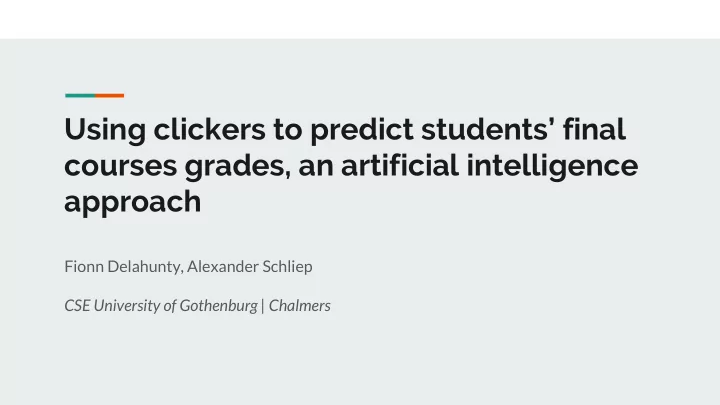

Using clickers to predict students’ final courses grades, an artificial intelligence approach Fionn Delahunty, Alexander Schliep CSE University of Gothenburg | Chalmers
Introduction Increased attendance by up to 50% [1] ● Improved attention spans during lectures [2] ● Improved student satisfaction [1] ● Self reported improved exam performance [3] ● Relationship: Clickers --- Exam performance in the contents of A.I
Previous Research Alireza Ahadi et al. “Exploring machine learning methods to automatically identify students in need of assistance”. Submitted assignments can predict grade bands with 90% accuracy
Previous Research Leo Porter, Daniel Zingaro, and Raymond Lister. “Predicting student success using fine grain clicker data”
Our Research Hypothesis 1) Do the number of clicker attempts related to outcome of the clicker result. Hypothesis 2) Can clicker data can be used to predict final course grades.
Data collection Two years worth of clicker data (82 & 130 students). 24 lectures per year, average 5 questions pre lecture, 12,896 questions Student ID Answer Final answer Number of Response Total time allocated time attempts changed to question 12345 Correct/Incorrect % of total time 1,2,3... Yes/No 60,80,120 seconds…
Hypothesis 1 The number of clicker attempts is related to outcome of the clicker result. Do students who change their answer many times, have less confidence in their knowledge and therefore are more likely to get the answer wrong?
Hypothesis 1) Distribution of Correct answers Distribution of Incorrect answers Mean = 4.97 attempts Mean = 4.92 attempts
Hypothesis 1) Take home message We shouldn’t judge students who made more attempts on a question.
Hypothesis 2) Can clicker data can be used to predict final course grades.
Possible uses: Tailoring academic student support Warning! Student XYZ is at 65% risk of failing DIT123 Introduction to coffee drinking. Warning! Student YPZ had trouble answering questions on Functional Coding. Offer support? Yes - No
Hypothesis 2) Exploratory Data Analysis Final Exam score Above 75% 50% to 75% 25% to 50% Less 25%
Hypothesis 2) Exploratory Data Analysis Final Exam score Above 75% 50% to 75% 25% to 50% Less 25%
Artificial Intelligence Classifier
Evaluating our AI system
Our results Final grade band +75% 50% to 75% 25% to 50% >25% 46% Accuracy
Hypothesis 2) Take home messages Students who did well in clickers and bad in exams? What does ● this means with regards to exam format. Conclusion: There is some predictable relationship between ● clickers and exams. Caveat: Our work was proof of concept, it’s not production level ● code.
Hypothesis 2) Take home messages Future work can be done on larger student cohorts. ● Chalmers/GU exam grading specific? ● A new way to tailor student support ●
Thank you for listening! Questions?
[1] Jacqueline O’Flaherty and Craig Phillips. “The use of flipped classrooms in higher education: A scoping review”. In: The internet and higher education 25 (2015), pp. 85–95. [2] Kathy Kenwright. “Clickers in the classroom”. In: Tech Trends 53.1 (2009), pp. 74–77. [3] Kathleen Hoag, Janet Lillie, and Ruth Hoppe. “Piloting case-based instruction in a didactic clinical immunology course”. In: Clinical Laboratory Science 18.4 (2005), p. 213
Recommend
More recommend